Not long ago, Ian McAllister was paddling his canoe in an estuary on Canada’s West Coast when he noticed “two furry ears” floating on the water nearby.
“They were attached to a grizzly bear snorkeling along looking for salmon carcasses that were bouncing along the river bed,” explains McAllister.
“The bear clambered up onto a floating log for a rest and I was able to drift within twenty feet of him to take this picture (shown above). It was an amazing way to end a day in the Great Bear Rainforest.”
And so goes the life of one of Canada’s finest conservation photographers – a man who has been living in the heart of Canada’s most remote rainforest, which spans from the northern tip of Vancouver Island to the Alaskan Panhandle, with his family since the late 90’s.
Lucky for Toque & Canoe and our readers, Ian agreed to share this selection of mostly unpublished images from his Great Bear Rainforest home – just listed by National Geographic as a must-see destination for travelers in 2013.
Photography – says the award-winning author of The Last Wild Wolves and co-founder of Pacific Wild – plays a vital role in the battle to protect Canadian wilderness.
“Human beings are a visual species. The right image can inspire people to act, to want to protect the planet. Finding that image is challenging in a landscape like Canada’s West Coast because the environment is dominated by rough weather, dodgy logistics, low light and lots of rain,” says Ian.
“So you’re dealing with all this on top of trying to photograph some of the most elusive wildlife in the world,” he continues. “Plus, I’m almost always alone, running my own boat, and every day there are calculated risks that need to be decided upon. The whole situation conspires to make tough image-making.”
We hope you enjoy Ian’s photos. We certainly did. The cutlines belong to him.
“The lifeblood of the Great Bear Rainforest, these pink salmon arrive on the B.C. coast in the millions and provide food for over 200 species. During this photo shoot, I lowered myself into a pool of fish inch by inch, so I wouldn’t spook them, and braced myself against some rocks as the water ran over me. It was a very cool moment, to be in the river with these fish that had just completed a miraculous journey having travelled thousands of miles through the open Pacific Ocean to return home to their natal river or stream. The collective wealth of over a thousand different salmon runs such as this one will be impacted by how Canadians choose to manage this sensitive area in the future.”
“The wolves of the Great Bear Rainforest have been sheltered by islands and remote wilderness for thousands of years. This genetically unique population may suffer the least amount of human persecution of any wolf population in the world. I have had to completely redefine my understanding of these highly social and intelligent animals as they give me access to their hidden world without aggression and fear. I think the ancient relationship that once existed between people and wolves is possible again, but not until the unwarranted notion that these animals are indiscriminate killers is wiped out. These animals deserve protection, not persecution.”
“Bat stars cling to a rock near Hakai pass, just south of Bella Bella. I was scuba diving with a tidal current running over me at seven knots. In order to grab pictures like this one, I had to brace myself in a rocky crevasse and try to be still enough to snap a shot. Not easy, but I was happy with this image because these stars were a kaleidoscope of exquisite colours.”
“Sibling spirit bear cubs patiently wait for their mother to catch a salmon. These globally rare bears have come to symbolize the struggle to protect the Great Bear Rainforest from human activity such as logging, trophy hunting and oil tanker traffic. They represent the mystery of this fascinating coastline. But in my mind, they equally represent the fragility of these vulnerable ecosystems.”
“Steller sea lions rest on the outer coast of the Great Bear Rainforest. The interface between ocean and rainforest is undefined for species like sea lions that depend on both environments for survival. For the record, a 2000 pound plus animal staring down at you is a humbling sight. Thankfully humans are not on the menu.”
“This is a spirit bear cub trying to cross one of the countless rivers that flow through the Great Bear Rainforest. It was heartbreaking to watch this cub trying to get across the river. Because if it failed, and got caught up in the current, it would have gone right over a huge waterfall – likely drowning. Normally, I don’t get involved with wildlife. But I think I would have jumped in for this little fellow. I was like, ‘Oh God, I hope this doesn’t happen!'”
“An evolutionary close relative of the Grizzly, the Steller sea lion is as clumsy as a bulldozer on land and as graceful as a mermaid underwater. The second largest known colony of Steller sea lions in the Pacific Ocean is found along the B.C. coast. While diving along a proposed oil tanker route near Hartley Bay, I was visited by about 200 of these graceful swimmers.
“This mother grizzly and her two cubs would walk from the forest to a small island each day at low tide. I just had to sit way up high with a long lens to catch their daily migration. I really believe that if the world could see how special this place is, there would be no question that it’s worth protecting. Living in the Great Bear Rainforest is a like a dream come true. But it comes with a responsibility to give back. In this regard, I hope the conservation work I do, the images I take, will make a difference.”
If you like our Great Bear Rainforest post, feel free to share it on your social media channels as a thanks to Ian (shown above).
If you have an interest in ‘real’ Canadian travel culture, remember to ‘like’ Toque & Canoe on Facebook or follow us on Twitter. Or, alternatively, sign up for our free e-mail postcard. (Just enter your e-mail in the blue box found on the right hand column of our website.)
Finally, do you have any thoughts on this story? If so, please comment below.
We love to hear from our readers – no matter where you are in the world!

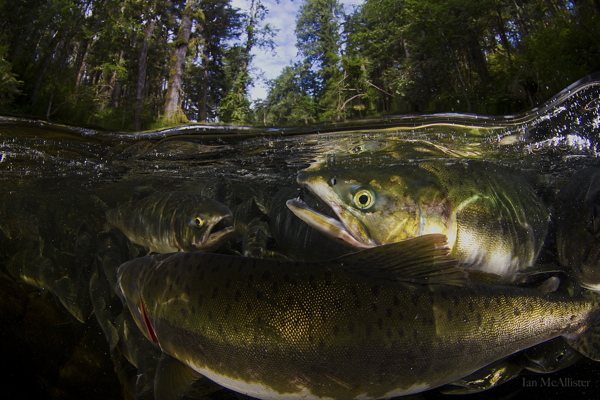
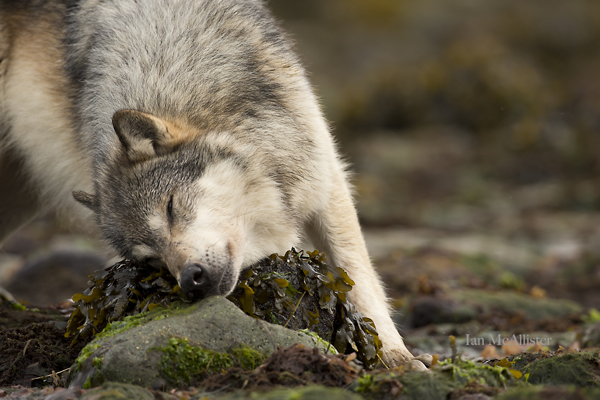
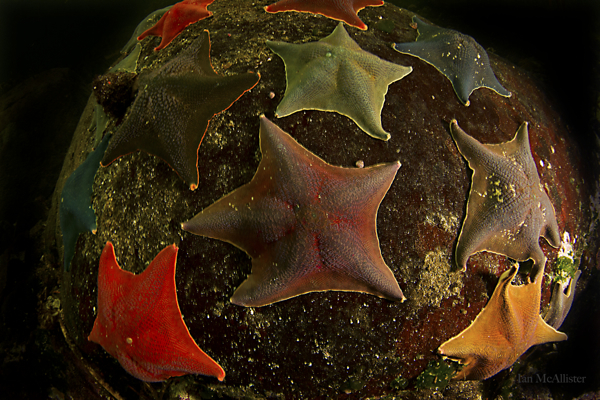
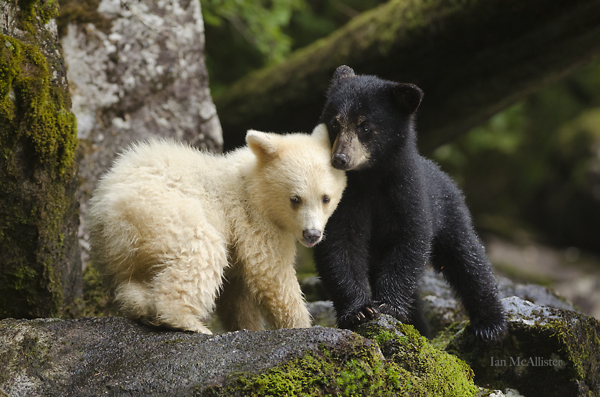
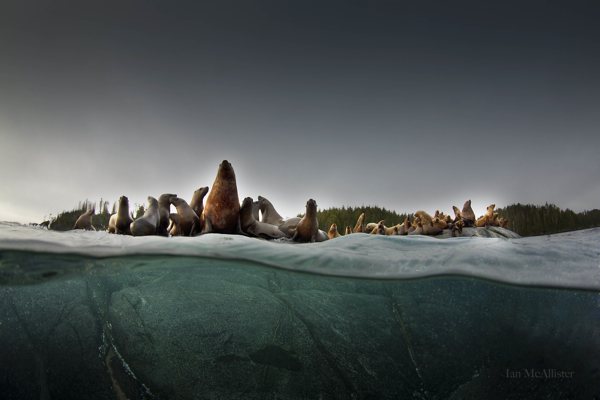


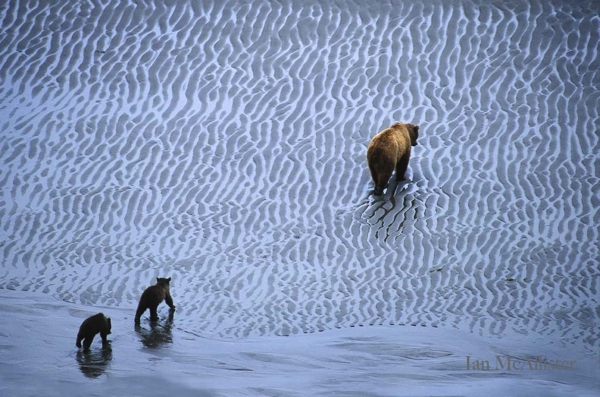
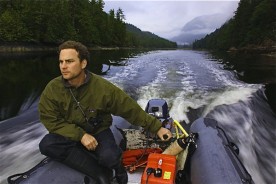

ds commented:
great place to go, great pictures, great article…keep up the exceptional work!!
OUTSTANDING!!!
Geoff Moore commented:
Thank you for this fantastic article with AMAZING images. Truly an inspirational piece.
Geoff Moore
Williams Lake BC
Emma commented:
Thank you, Ian McAllister, not only for the magnificent photographs and the accompanying commentaries from which I’ve learned so much but for the work you are doing. How can we not support your efforts to preserve the habitat of these beautiful creatures not just for future generations but for the good of all things living. The very thought of oil-slickened water sickens me.
Phillip Tureck commented:
The Great Bear Rainforest first grabbed my attention when I read Ian’s book the Last Wild Wolves. I was so enthralled by this book that Ian and I became friends over time and we met when Ian was invited to lecture at the Royal Geographical Society in London, Geography’s most illustrious venue.
This highlighted the beauty of the Great Bear Rainforest and its wildlife being presented to a much wider audience here in the UK.
This year I will have the opportunity to reciprocate and visit the forest for myself and no doubt I will come back with tales of what is one of the most incredible pristine places remaining on our planet.
Then I too will share the majesty of this wonderful place with others.
Thanks for publishing this brilliant article.
Phillip
Steve Cappello commented:
I am truly blessed to have lived and worked in the Great Bear Rainforest on and off for the past 20 years. From the very first time I stepped off the ferry and have since done quite a bit of boating and paddling, it has had a lasting impact on my life. It is truly a special place with very special people and I highly recommend to anyone to go and see and experience all that it has to offer for yourselves. I am lucky to call Ian a friend as well and have so much respect and admiration for him and am so grateful that we have people like him, his wife and others at Pacific Wild that bring awareness to what is at stake if we don’t protect this area, its ecosystem, and its people and their way of life.
Don Enright commented:
I found these images deeply moving- like peeking into a secret world, where wildlife and people somehow trust one another. What a remarkable feeling – not only to wonder and love, but to want more than anything to be worthy of that trust.
Fine, fine work here. Congratulations.
Peter Yonemori commented:
Just a wonderful place. The pictures are simply inspiring.I had the chance to be there for a few days last year and i think it was the best i have experienced so far.
This article is just great. I hope it could inspire the rest of Canada to prevent people from planning irresponsible projects. The Pipeline to Kitimat has to be
stopped !
Mia M commented:
Thank you, Ian, for exceptional photos now and always! You are so right when you say that “The right image can inspire people to act, to want to protect the planet.” Your work plays such a significant role in our society where “development” is more promoted than protection. I will bring these images to the school where I work so that we can share them with our students and talk about them. Thank you, thank you!
Melanie Gauthier commented:
Simply breathtaking! Images say more than words. We have a duty to protect those animals and their habitat. Thank you Ian.
Lorna Crozier commented:
Seeing these pictures and reading these words made me feel the way I do when I come across an animal in the wild. The space between me and the fox or the deer or the coyote shrinks and we are two creatures looking at each other. Thanks for giving me that feeling all over again. These photographs are among the most moving and beautiful I’ve ever seen, but Ian, did the bear cub make it across the river?
Congratulations on an amazing piece.
PROF. PARTHASARATHI CHATTOPADHYAY commented:
A collection of superb & rare photos! These speak highly of the degree of patience IAN had to put in to take these remarkable shots. Will you please tell us what camera & lens combination & exposure settings you did use in each photograph?
The photographs reflect not only your professional skill but also your depth of knowledge of Canadian wildlife & GBR topography……..Thanks IAN…….Keep going…….
Lynn commented:
Amazingly beautiful! Thanks for sharing T&C and Ian. We are fortunate to have people like Ian work to conserve the beauty of the world. Humbling for sure.
Diane commented:
A friend posted one of the photos on Facebook so I clicked on it and was greatly rewarded with the rest of the photos. Thank you so much for sharing what I will, in all probability, never see in person. The animals are lucky to have you!
Heath Purdy commented:
I will not rest in my lifetime until the Northern Gateway and other hellish projects like it are stopped in their oil money tracks. The BC coast is unique and cannot be `cleaned up“ or replaced after a catastrophic oil spill. I thank Dogwood and Ian for the super pictures and untiring work to halt the madness…..
Laurie commented:
Simply majestic
Thank you Ian for sharing your gift
Your works
Your experience
To bring the ultimate need of awareness
Please let us all know how we can be
Of most help in protecting
As I believe that is our real purpose
Kathy Duperron commented:
These photos are great reinforcement for people writing letters, signing petitions, posting information, and attending protests and rallies. Beautiful. Thank you.
TamAirah commented:
Mother Earth is working through you Ian! You are her true witness! ;-D
Fireweed commented:
Your work continues to inspire awe, appreciation…and action! Thank you Ian McAllister…it’s up to all of us to demand protection …your help in reminding us all why is priceless.
amber and 'rinny the rinpoche' commented:
YES! These photos and wise words have warmed my heart. I’ve shared this with my loved ones, and please know that you are making a difference and are doing a wonderful job. THANK YOU, and keep up the awesome work!
Love, Amber and Rinny
Deb Kinvig commented:
I love these pictures of our beautiful wildscapes. Thank you for these.. They do my heart good…
beau purvis commented:
I am probably one of a few that are for the Keystone pipeline that would go to the gulf in the U.S. The reason…then Canada will not keep pushing for the pipeline that would end up with ships carying their dirty oil to this Great Bear area and over a ton of rivers along the way!We stopped the danger to the Sacred Headwaters…we can’t let this go through the Great Bear Rainforest. I am a lucky one that has been there…it has to stay as it is!
Nicole Best Rudderham commented:
thank you! The rest of non-BC needs to see and understand our treasures!
Juergen Boden, Germany commented:
Oh, Ian, what a wonderful article and enthralling photos of “your” (“our”) Great Bear Rainforest and its God-given wildlife. You have fought for the protection of it in person, in books, in films since the early 1990s – and have achieved incredibly large attention throughout the world, but governments in Canada have not really listened to what you have said ab out this last paradise along the Pacific Coast. Shame on all of them! We published in German your book “Canada’s Forgotten Coast…” with a wonderful success here in the German speaking countries, and also your book “The Last Wild Wolves” raised a lot of sympathetic reactions here in Europe. But it finally is up to the BC government and your Federal government to protect this last expanse of wilderness, and as with so many other wild regions of your country, that protection will fall far short of what is and will be needed. Thanks, Ian and Karen – you are our Heroes and will always stay our heroes!
marcus commented:
This story makes me want to move back to BC right now. Great work and beautiful images.
Ryan commented:
Beautiful! Hope to visit this area in the summer!
penelope Truex commented:
These are beautiful photos. I cannot help but wonder what happened to the little spirit bear. I was reminded of oneof the many lessons I learned from my Cree medicine man, about the little bears being a totem of health. Good work. You are living a good life there part of the nature of the place. Thank-you.
Craig commented:
Glad to see such great talent in such a beautiful part of our planet!
Jayanthi Srinivasan commented:
Sir,I can’t explain my feelings.The beauty of the place simply enchants me.It is the duty of every human being in this world to protect this paradise and its inhabitants.
sheila luesley commented:
love the beautiful photos on here.thank you so much
Brad Cousins commented:
A rare talent indeed that has a vision of the world not only as it is now, but how it should be preserved. These images inspire in a slightly haunting way, as they recall how much of the world used to be.
Christine Smith commented:
What absolutely amazing photo’s of this most beautiful part of the world. What fantastic rewards for the hard work you must have put in to be there, and stay there. It’s the closest thing to actually being there. Thanks for sharing.
Taco Nieuwenhuis commented:
Thanx!
Marian commented:
Amazing pictures and wonderful insight to life in the Great Bear Rainforest. Thank you for sharing.
Beth commented:
Do you have organized hiking trips, etc?
Tina Duff commented:
These photos are beautiful. They were obviously hard to capture but I could look at these images for hours. Well done Ian McAllister. I’d never heard of that forest before but I’ll be on the look out for your books from now on.
Deborah Trimmer commented:
Thank you for sharing your perspective with your photography. This was an amazing trek to take with you. I’ve shared your blog. Wishing this blog to become a viral sensation so the world can share this pristine place, without harming it.
Kary Firstbrook commented:
Beautiful images Ian and thank you for all your work in those remote and dangerous locations on the west coast. Thank you for raising the awareness to the public on how valuable this rare rainforest area is to the world and how we need to preserve it for future generations. NO tankers PLEASE!!!!!!!!
Kari Gulbrandsen commented:
Beautiful! Is it possible to get prints of these?
Rick Williams commented:
Truly significant and compelling worth, both the mystical images and the messages they convey about the crucial need to conserve this magical environment. Thank you.
Jenn Jilks commented:
Kim Gray did a great interview on In Town & Out. Well done! We had a black bear in our backyard last month, but this trip must have been much more exciting! I will be visiting my acton-son in Chemainus next month. Trying to figure out how to get my camera equipment, as well as clothes, on as a stand-by flyer!
Amazing photos here. I appreciate seeing these critters virtually!
Danielle Bridger commented:
WOW!!! Thanks so much for an unforgetful view of our wonderful wildlife. Indeed it is worth protecting. Continue your work that I for one encourage and support.
Christine commented:
Thank you for showing Canadians and the rest of the world such a special place with such extraordinary photographs. And thank you CBC for introducing us to you.
Jane McAllister commented:
Again your images and words leave us speechless and with great respect for the work you and Karen do. Well done, Little Trout.
Robyn commented:
I never knew such a place existed in Canada. Thank you, CBC, for the introduction to The Great Bear Rainforest. I will travel here one day with my children and husband. Ian, your images are magical.
Donna commented:
I heard of this excursion on CBC radio. Thanks CBC and Thanks Ian for informing me of this most beautiful place in Canada. Looking forward to turning 50 and enjoying this trip!
Frances Graham commented:
Love your pictures, Ian, especially the underwater salmon and sea lion.
Phillip commented:
I have been, seen, marvelled, spent time with the guides and met up with Ian. It is truly an incredible place, even on days that teemed down with rain the views of the mountains and trees were incredible.
Wildlife, can never get tired of seeing it, living it, breathing it.
Just need to get organised and visit again sometime in the near future.
A few pictures on the website to see.
jitze Hooijsma commented:
Philip, you’re right !!
Wildlife, can never get tired of seeing it, living it, breathing it.
Jitze Hooijsma commented:
Breathtaking foto’s !!
I hope I once will be able to visit these forests and find out about my own, these incredible nature.
And I hope too I will be able to meet the wolves over there and find out the same as you….
Angela Gnyp commented:
I loved seeing these photographs from the most beautiful place in the world. The landscape of this region is too precious to ruin with a pipeline.
Victoria Ross commented:
These are the absolute CUTEST pictures. OMG. The wolf and little bears have actually made my day and have become my new background. Thanks so much:)
-V
Evie Hanlon commented:
Terrific post. Awesome photographs. Thanks for giving us a window into this beautiful part of the world.
Joyce Keay commented:
Beautiful pictures! Thanks for sharing!
Donna Holmes commented:
So enlightening to see these wonderful creatures. Protecting the wolves should be a number one issue. Thanks for this article.